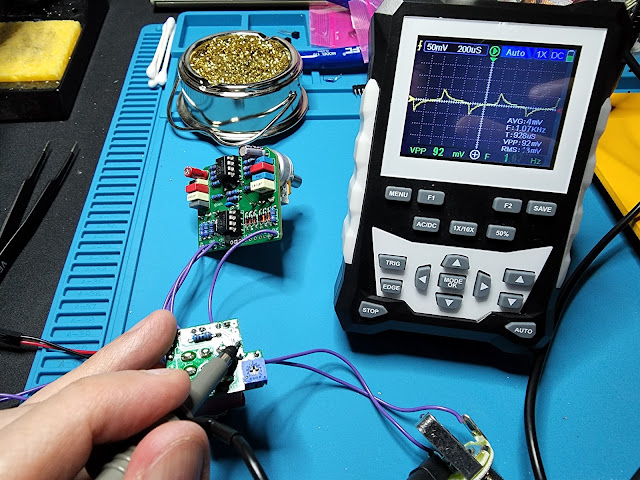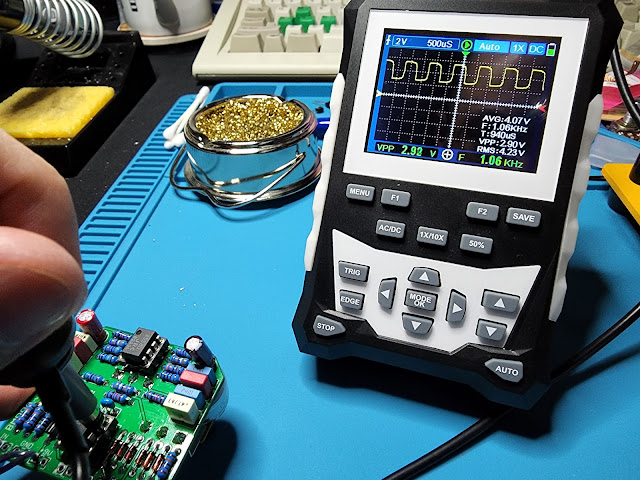New circuits from GuitarPCB and debugging the GuitarPCB Big Muff Pi Opamp board
New stuff (and some bugs)!
I ordered a few PCBs from GuitarPCB.com. It's becoming one of my favorite place to order PCB from. Instructions are clear and the PCBs are top quality. Barry (the owner) is always helping on the forums and so far I've had nothing but success.
The new stuff
Here's what I ordered in the last few weeks:
- two different Big Muff Pi circuits (Big Muff Pi Muff'N built to the Skreddy Pedals Mayonnaise Muff specs, and the Big Muff Pi Opamp)
- many One Knob Fuzz (they are so fun and easy to built and incorporate in anything that needs a fuzz)
- 4-Track Fuzz (which sounds like the distortion on old recording equipment when audio levels are maxed)
- Industrial Fuzz (based on ZVex Fuzz Factory)
- Sriracha Fuzz
- Ratt Deluxe
- a few Emerald Ring octave-up daughter board
- Plexi-Plus (similar to the Marvel circuit)
- Bass Driver (SVT preamp-style)
- Bass OD
- Add-Verb reverb
- Mini Me MN3207-based with CD4047N clock driver chorus
- a few Buff N' Blend
- their 3PDT Vari-Brite helper boards that are absolutely essential and huge time-savers
I've already built a few of them and they are great, but let's turn our attention the Big Muff Pi Opamp PCB.
The bugs
The squealy Big Muff Pi Opamp
The circuit is fairly simple. It's a typical Big Muff Pi circuit, but instead of using four transistors, it has two 4558D dual op-amps (so it's still a four-stages fuzz). I assembled it in combination with a Buff N' Blend board that provides a "transparent" buffer, and allows to mix the dry signal with the wet signal. This will be relevant later.
Once the build was complete, I tested the assembly and I was met with a nasty high-pitch "squealing". I could manage to almost kill it entirely by playing with the sustain and tone knobs, but it's always there. I checked pretty much all I could think of:
- EM interference
- ¼" stereo jacks picking up noise
- Dirty power supply
- Bad solder joint(s)
- External wiring problem
- Bad part(s)
I first did the tweezer test. That is when you use a pair of tweezer and start touching exposed terminals and see what happens. On most terminals, not much happened. Some did nothing, and with some others you'd hear something at the output - standard stuff. Now, whenever I touched pin 3 of the volume potentiometer, or pins 1 and 2 of the the tone potentiometer, the high-pitch noise became extremely louder. However, when I touched pin 3 of the sustain potentiometer, it quieted down and sometimes would stop entirely. Now that's interesting. I could also hear whenever the jack would rub or hit my desk. If I flicked the tip terminal of the jack or just simply scratch the metal housing of the plug on the cable, I'd hear it.
I replaced the sustain and tone potentiometers based on these observations, and I also replaced both 4558D op-amps with spares I had for good measure. The squealing is still very much audible.
I posted on the GuitarPCB forums about this odd issue where I mentioned my hypothesis of a grounding issue, which was also the diagnosis Barry (the main GuitarPCB guy) gravitated towards. He recommended a full reflow of every solder joints and redoing the external wiring, which I did with no success. I also decided to remove the Buff N' Blend and put a 3PDT Vari-Brite board like I usually do. Still, the noise persists. Then I changed my stereo jacks for mono jacks. No dice; still noisy. That's when I decided to get the oscilloscope out and track where that nasty sound is injected at.
Some poking with the probe later, I suspected IC1 to be the culprit, and I found some interesting clues:
Pin 6 of IC1 showed a sine wave of a much lower amplitude with a frequency of 1.13kHz. It's interesting to note that touching that pin with the oscilloscope's probe changed the nature of the sine wave and the sound coming off the amp it was connected to was different.
Pin 5 showed absolutely nothing on the oscilloscope - HOWEVER - touching it with the grounded oscilloscope probe caused the high-pitch sound to stop. Completely. It looks like my intuition was right and it is indeed a grounding issue.
I checked a few more thing including pin 7 of IC2, which outputs a square-ish waveform. Not entirely unexpected since the signal went through the clipping diodes:
Armed with the knowledge that grounding pin 5 of IC1 solves the issue, I used the schematic from the build document to see exactly with pin 5 is doing.
Pin 5 is part of the second opamp of IC1 (IC1B), receiving its input from the output of the first opamp of IC1 (IC1A, pin 1). There a voltage divider set up with R4 and R5, that reinjects part of the IC1A output at pin 7 through a film box capacitor. Some of it is bled to ground through C2, which is a 10n film box capacitor. Well, it looks like C2 is not capacitating correctly.
This capacitor was a Kemet that I got from Mouser. It being bad is somewhat surprising as I have an excellent track record with Kemet parts. It's still possible that it is out-of-specs or that it simply just failed, so I replaced it with, well, the exact same thing since that's what I have on hand for that particular value.
Once the "faulty" capacitor was replaced, I heard silence. Just the usual background noise of an overamplified signal. No high-pitch squealing. Perfect! Now let's test the capacitor to see what's going on.
With that problem sorted, let's put back the Buff N' Blend instead of the 3PDT Vari-Brite. I managed to resolder the wires without having to shorten them again, which is good.
The Buff N' Blend "transparency" issues
The Buff N' Blend is an awesome little circuit board. It allows you to mix the dry signal into the wet signal, which is awesome for bass where tone suckage might happen.
The circuit is fairly simple: a JFET acts as a buffer and splits the signal in two before recombining them: one goes straight to the output, the other goes to the effect board. A potentiometer controls the balance between both. I've assembled only two of these: one that went on a One Knob Fuzz, and this one.
As soon as I placed the Buff N' Blend back, the squealing returned, but only when the sustain is more than halfway up. Now that's odd. Since my oscilloscope was nearby, I checked a few voltages and waveforms. First: what's going out of the buffer. I could see the waveform clear as day coming out of the JFET. I checked the input jack, and it's not there. Unless yet another capacitor is shot - which, let's face it, is a possibility - there's a problem.
Next, I checked the waveform at the board input, and I see... 5.02V?!? That is definitely a problem. Just to be sure, I pull out the One Knob Fuzz I assembled earlier that also exhibit a similar issue in the last third of the volume knob, but I originally blamed it on the extra-gainy transistors squealing and oscillating (both have an hFE of roughly 380). Anyways, same thing: 5.02V on the board's input. OK, what the h-e-double-hockey-stick is going on here?
To recap: the JFET is not transparent, it introduces a sine wave of some sort, and it send way too high of a voltage at the output (usually, we're talking perhaps around 150mV from the instrument; not 5V). That sine wave gets picked up by the transistors or the op-amps, and gets amplified along with the rest. Lovely.
According to the documentation, the recommended JFET is a J113. That's what I originally used in both Buff N' Blend I assembled, but I have some NTE469 which are functionally equivalent. I gave them a shot, and - you guessed it - that gnarly sine wave is still present.
That's where I'm at with the Buff N' Blend. I did not get time yet to fully analyze what's going on or if any of the things I observed are normal, but I'll definitely ask for help on the GuitarPCB forum again. Perhaps I missed something important. Once I have more info, I'll make an update post about that.
Header image: FreeImages.










Comments
Post a Comment